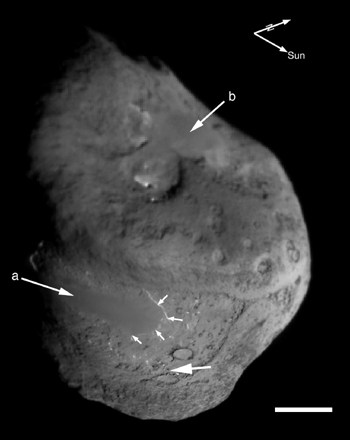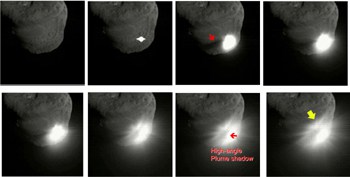The first results from the Deep Impact mission to the comet Tempel 1 have shown that the material inside the comet is different to that on the surface. This is confirmed by data from the Rosetta spacecraft -- which is on its way to another comet -- and a host of ground-based telescopes. The Deep Impact mission consisted of a flyby spacecraft and an impactor - roughly the size of a washing machine - that crashed into the comet in the outer reaches of the solar system on 4 July this year.

Comets are the “undercooked leftovers” that remained after clouds of dust and gas condensed to form the Sun and planets some 4.5 billion years ago. Unlike other objects in the solar system, comets have barely changed with time and contain pristine material – such as ice, dust and gas – from the early days of the solar system. Some scientists also believe that comets could have carried the organic molecules needed to start life on Earth.
The first images of the collision between the impactor and Tempel 1, which took place about 133 million kilometres from Earth, showed clouds of dust and ice being ejected from the impact site. The impact was designed to disturb material inside the comet so that it could be analysed by the instruments on board the flyby spacecraft as well as various ground and space-based observatories. The first set of results from the mission will be published on Sciencexpress later this week.
Based on data from the flyby spacecraft and the impactor, Michael O’Hearn of the University of Maryland and colleagues say that Tempel 1 belongs to the Jupiter family of comets, although its overall shape and surface features are quite different from the nuclei of the two other comets that have been studied in detail — Wild 2 and Borelly. They also report that Tempel 1 consists largely of extremely fine particles that seem to be very loosely bound together: in other words, the comet is more like a pile of powder than a solid rock. The outer layer of the comet is composed of particles that are between 1 and 100 microns in size, while the density of the nucleus is about 600 kilograms per cubic metre (Sciencexpress 1118923).
In addition to the material ejected by the impactor, the flyby spacecraft also saw shallow outbursts of material – probably triggered by sunlight – with a mean radius of about 3 kilometres. This ejected material mainly contain water and carbon dioxide. Furthermore, a relatively high concentration of organic material, such as formaldehyde and methanol, was found to be more abundant than water and carbon dioxide during and after the impact.
Meanwhile Karen Meech of the University of Hawaii and an international team of colleagues used more than 70 different telescopes to follow the action from the ground. Again, these results suggest that the composition of the material ejected after the impact differed from that produced in natural eruptions. This means that the material inside the comet is different to that on the surface (Sciencexpress 1118978).
Finally, Horst Uwe Keller of the Max Planck Institute for Solar System Research and co-workers used the Rosetta mission – which is on its way to another comet called Churyumov Gerasimenko – to survey the collision at from a distance of 80 million kilometres over a period of 17 days. Again they found that the relative amount of organic material being ejected increased following the impact. Keller and co-workers also observed a dip in brightness about 200 seconds after the impact, which they say is related to the formation of a city-sized crater on the comet (Sciencexpress 1119020).




